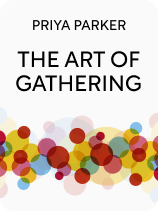

This article is an excerpt from the Shortform book guide to "The Art of Gathering" by Priya Parker. Shortform has the world's best summaries and analyses of books you should be reading.
Like this article? Sign up for a free trial here.
Are you throwing your first party? How do you host a party?
Hosting your first party can be intimidating. You want people to have a good time and mingle, but you may not know how to make that happen. With Priya Parker’s book The Art of Gathering, you’ll learn how to easily manage the gathering so that your guests will have fun.
Here’s how to host a party when your guests start to arrive.
How to Begin the Gathering
Parker argues if you don’t handle the beginning stages of your party right, all your pre-gathering work will have been wasted. To learn how to host a party to the best of your abilities, Parker suggests that you pay attention to two key moments: the arrival and the opening.
Manage Your Guests’ Arrival
Parker suggests that you manage your guests’ arrival by introducing a clear physical or metaphorical transition into your gathering. When your guests arrive, they will be mentally wrapped up in whatever else is going on in their lives—like the fight they just had with their sister. By providing them with an appropriate transition, you encourage them to forget about everything else and refocus their attention on your gathering so they can be fully engaged.
(Shortform note: If you (as a guest) are preoccupied with an unrelated event before entering a gathering, it’s arguably your responsibility (not the host’s) to manage your worries so that they don’t distract you from participating fully in the gathering. Try meditating or journaling before the gathering so that you can clear your mind slightly and enter the gathering as a blank slate.)
The simplest and most literal transition, Parker points out, is a doorway. What you do at the door can help shape your guest’s experience; for example, greeting your guests at the door as if you’re at a wedding will help set a more personal tone for your event. You can go one step further and decorate a hallway in keeping with your event—just as Disneyland designs the hallway into their rides with thematically related items. Alternatively, create a psychological transition. Parker describes how one comedian, prior to starting his set at a charity event, captured the attention of his audience by asking the loudest member of several conversational groups to introduce themselves and then asking everybody to clap.
| How to Create Meaningful Transitions In The Power of Moments, Dan and Chip Heath agree that transitions have the potential to become memorable and meaningful when you engineer a clear moment that carries you from one stage to the next. They recommend that to engineer meaning, you should deliberately incorporate one of the following four elements: elevation (above everyday experience), insight (an opportunity to discover something new), pride (a sense of validation), or connection. You can creatively incorporate these both into physical and psychological transitions. For example, the comedian Parker describes created a sense of pride for those being applauded and a sense of connection between them and the rest of the audience. And greeting your guests at the door provides a sense of connection. |
Open Right
After properly transitioning into your gathering, turn your attention to the opening. Parker explains that you must open in a way that sets the tone for the gathering.
Parker argues that opening right matters: Studies suggest that most people tend to remember beginnings—so how you open will linger most in people’s memory. However, most hosts at gatherings open with organizational matters, such as by thanking sponsors. At best, opening with organizational matters misses an opportunity to harness the pre-gathering momentum you’ve created into a powerful moment. At worst, it may undermine the reason for gathering. For example, if you frame a conference as game-changing and disruptive but start with a boring list of rules, you send the message that you’re following old rules.
| Why Beginnings Matter In When, Daniel Pink elaborates on the power of beginnings. He explains that people feel more optimistic and capable at the start of something, partly due to a psychological phenomenon known as the “fresh start effect”: Beginnings give people the opportunity to mentally distance themselves from their past mistakes and envision a different (improved) version of themselves. This may explain why a powerful opening is so beneficial—and why a boring opening is so damaging. A powerful opening doesn’t just linger in your guests’ memory; it also provides a clear psychological distinction between the person they were pre-gathering and the person they’ll be post-gathering. But a gathering that opens with logistics doesn’t provide that clear distinction—so the experience won’t ever impact your guests as powerfully as it otherwise might have. |
To open right, Parker recommends that you first make your guests feel accepted and grateful to be at the gathering. This will make them feel like they’re part of something special. Parker describes how one professor memorized every student’s name and then greeted each by name on the first day of a 70-person class: This made the students feel special and demonstrated the professor’s impressive ability.
(Shortform note: In How to Win Friends and Influence People, Dale Carnegie explains why remembering your guest’s name makes them feel accepted and grateful. A person’s name is their favorite word so saying it is a subtle and welcome compliment. However, in How to Stop Worrying and Start Living, Carnegie warns against expecting gratitude from your guests for your opening—no matter how well-thought-out. Ingratitude is human nature, so expecting gratitude from others will only lead to resentment on your part. Instead of risking being disappointed that your guests don’t feel grateful, consider focusing on the joy of giving them an impressive opening—without expecting anything in return.)
Second, Parker suggests that you create a collective among your guests. As a host, it is your job to make the guests feel like they are part of a group. One simple way to do this is to get your guests to acknowledge each other’s presence and learn something about each other. For example, you might ask your conference attendees to introduce themselves to each other at the table.
(Shortform note: In her guide to virtual gatherings, Parker suggests that providing breakout rooms in which your guests can chat will help them feel like more of a collective. Having unstructured time in which they can briefly get to know each other will help them connect in a way that’s often difficult to do online.)

———End of Preview———
Like what you just read? Read the rest of the world's best book summary and analysis of Priya Parker's "The Art of Gathering" at Shortform.
Here's what you'll find in our full The Art of Gathering summary:
- How to make pre-planned gatherings more meaningful and engaging
- What to do before, during, and after any type of gathering
- Why the host should never relax during their event






